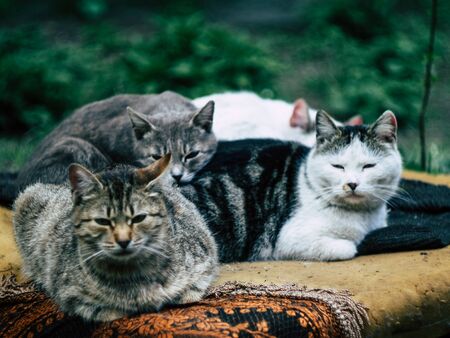1. Understanding the British Cat: An Overview of Feline Social Behaviours
Cats are a quintessential part of British homes, weaving themselves into the fabric of family life with their distinctive personalities and subtle social cues. In the UK, common breeds such as the British Shorthair, Maine Coon, and domestic moggy each bring unique traits to multi-cat households. The British Shorthair, for instance, is often lauded for its calm and gentle nature, preferring peaceful coexistence over boisterous play. Meanwhile, moggies—beloved mixed-breed cats—can range from outgoing to reserved, making each intercat relationship truly one of a kind.
British cats tend to reflect their environment: many grow up in terraced houses or flats where shared indoor space becomes a stage for complex feline interactions. Their personalities are shaped not only by genetics but also by the quintessentially British approach to pet care—one that values patience, respect for boundaries, and an understanding that every cat has its own comfort zone. This deep-rooted respect influences how cats communicate with both humans and their fellow felines. Some might greet a new arrival with a gentle headbutt or slow blink, while others prefer to observe quietly from a distance before initiating contact.
Such diversity in temperament means that successful multi-cat living in the UK often hinges on careful introductions and ongoing observation. Understanding these subtle social behaviours is key to fostering harmony in homes where more than one cat reigns. By recognising the unique quirks and preferences of our feline companions, British cat owners can better support positive interactions—and help every whiskered resident feel truly at home.
2. Establishing the Pride: How Cats Form Relationships in Multi-Cat Homes
When welcoming more than one cat into a British household, you are essentially setting the stage for a fascinating social drama. Each cat brings its own personality, preferences, and past experiences, all of which play significant roles in shaping intercat relationships. Understanding how these relationships develop helps ensure harmony and wellbeing within your feline family.
The Foundations of Feline Bonds
Cats are often misunderstood as solitary creatures, but many are capable of forming close friendships—especially if introduced thoughtfully. In UK homes, where space might be limited compared to rural counterparts, cats learn to adapt by negotiating their social environment. Early positive introductions set the tone for peaceful cohabitation. For instance, kittens raised together or related cats tend to bond more readily, grooming each other and even sharing sleeping spots. However, with unrelated adults or rescues, patience is key; slow, scent-swapping introductions using familiar British items like jumpers or blankets can ease tensions.
Hierarchy and Territory: The Unseen Rules
Hierarchies emerge quietly in multi-cat homes. Some cats naturally assume leadership roles—often the most confident or senior feline—while others are content to follow. This pecking order is rarely enforced through aggression; more commonly, it’s communicated by subtle cues such as who claims the sunniest windowsill or the prime spot on a favourite armchair. British cat owners often observe these silent negotiations and adjust resources accordingly to prevent disputes.
| Aspect | Common Behaviours | Owner Tips |
|---|---|---|
| Bonding | Mutual grooming, nose touching, sleeping together | Encourage with group play and treats; never force interactions |
| Hierarchy | Subtle avoidance, waiting turns at food bowls | Feed in separate bowls and locations if needed |
| Territory | Scent marking, occupying specific rooms or furniture | Provide multiple litter trays and resting spots around the house |
Success Stories from Across the UK
Many British households have celebrated success after carefully orchestrated introductions. For example, one London family found that their adopted rescue cat blossomed into a confident companion after several weeks of scent swapping and supervised meetings with their resident moggy. Sharing positive progress with local cat groups often provides encouragement for others facing similar challenges.
Common Challenges and Solutions in British Homes
- Tension over shared resources: Addressed by providing extra feeding stations and litter trays (the golden rule: one per cat plus one extra).
- Noisy disputes at night: Often minimised by establishing separate sleeping areas and sticking to consistent routines.
- Territorial spraying: Managed through neutering/spaying and stress reduction techniques like pheromone diffusers.
A Thoughtful Approach Yields Harmony
The journey toward a harmonious multi-cat home is paved with patience and observation. With careful planning and an understanding of feline social structures—which are surprisingly nuanced even within the smallest British flats—owners can nurture a peaceful pride where each cat thrives.

3. Communication Among Cats: Signs, Sounds, and Scents
Within the bustling environment of multi-cat homes across the UK, feline communication unfolds in a quietly intricate dance of body language, vocalisations, and scent marking. Understanding these subtle cues is key to nurturing harmonious relationships among your cats, and helps us humans better interpret the unique social world our companions inhabit.
Body Language: The Silent Conversation
Cats are masters of non-verbal communication. In a typical British home with several moggies sharing space, you might notice gentle nose-to-nose greetings—a friendly gesture akin to a handshake. Tail positions also speak volumes: an upright tail often signals confidence or welcome, while a swishing or puffed-up tail can indicate agitation or excitement. Watch for slow blinking between cats; this “cat kiss” is a sign of trust and comfort within their social group.
Vocalisations: From Chirps to Growls
Though often described as quiet creatures, cats in multi-cat households develop a diverse repertoire of sounds to express themselves. You may hear melodic chirrups as they greet each other, or trills exchanged during play. Hissing and growling, on the other hand, are clear warnings—especially when new cats are introduced to an established group. Over time, you’ll learn which meows signal playful invitations and which communicate boundaries that should be respected.
Scent Marking: The Hidden Messages
Scent plays a profound role in feline society. In many UK homes, it’s not uncommon to see cats rubbing their cheeks against furniture—and sometimes each other—to deposit pheromones from facial glands. This behaviour marks territory as safe and familiar, reducing tension among housemates. Shared grooming sessions further exchange scents, reinforcing bonds within the clowder (the delightful collective term for a group of cats). Litter trays and scratching posts become communal message boards, so ensuring plenty of resources helps minimise disputes over territory.
By observing these forms of communication in your own home, you’ll gain invaluable insight into your cats’ social dynamics. Whether you have two or ten feline friends curled up by the radiator or sunning themselves on the windowsill, appreciating their ways of interacting fosters a peaceful and enriching environment for all.
4. Managing Disagreements: Conflict and Harmony in Shared Spaces
Living with multiple cats in a British home can be both rewarding and challenging, especially when it comes to managing disagreements among your feline companions. Understanding how to recognise tension, prevent altercations, and encourage harmony is essential for a peaceful household.
Recognising Signs of Tension
Cats are subtle communicators, often expressing discomfort or irritation through body language rather than overt aggression. In the close quarters typical of UK homes—think terraced houses or cosy flats—it’s important to spot early warning signs to prevent escalation.
| Behaviour | Possible Meaning |
|---|---|
| Flattened ears, dilated pupils | Anxiety or fear |
| Low growling, hissing | Verbal warning to back off |
| Stiff posture, tail flicking | Irritation or agitation |
| Avoidance, hiding | Desire to escape confrontation |
| Paw swatting (without claws) | Mild rebuke or playful assertion of boundaries |
Preventing Fights in Shared Living Spaces
Prevention is always better than cure when it comes to intercat conflict. Here are some tailored tips for typical UK living environments:
- Provide Multiple Resources: Ensure you have more food bowls, water stations, litter trays, and scratching posts than you have cats. In smaller British homes, consider vertical space—install cat shelves or window perches to expand territory.
- Create Safe Retreats: Cats value privacy. Offer hideaways such as cardboard boxes or igloo beds in quiet corners so each cat has somewhere to retreat without being disturbed.
- Scent Swapping: Regularly swap bedding between cats to promote familiarity with each other’s scent—a technique especially helpful when introducing new cats.
- Avoid Forced Interactions: Let cats approach each other on their own terms. Never force them together, particularly in confined areas like hallways or landings common in UK homes.
- Supervise Play: Use interactive toys (like fishing rod teasers) to redirect any excess energy and reduce the chance of play turning into a scuffle.
Fostering Peaceful Coexistence
The goal is not necessarily for all cats to become best friends, but for them to tolerate and respect one another’s space. Encourage positive associations by offering treats or praise whenever they share a space calmly. Consider pheromone diffusers (readily available from British pet shops) which can help create a calming environment. Finally, keep routines consistent—British cats thrive on predictability just as much as their human companions do.
5. Human Influence: How UK Owners Can Support Positive Intercat Relationships
As British cat guardians, we hold a special responsibility in shaping the social lives of our feline companions. The unique characteristics of UK homes—from cosy Victorian terraces to modern flats—call for thoughtful strategies that support harmony among multiple cats. Here are some practical and culturally relevant ways to nurture positive intercat relationships and promote social wellbeing.
Feeding Routines: Minimising Mealtime Stress
Cats are naturally solitary eaters, so communal feeding can sometimes spark tension. To encourage peace, provide each cat with their own food bowl and space them well apart, ideally out of each others line of sight. In smaller UK homes or flats, use different corners or even separate rooms if possible. Stick to regular feeding times, as consistency helps reduce anxiety and allows each cat to anticipate their own meal without feeling threatened.
Litter Tray Logistics: A Key to Harmony
The classic rule—one litter tray per cat, plus one extra—is particularly important in multi-cat British households where indoor space may be limited. Place trays in quiet, accessible spots away from busy walkways or noisy appliances. Avoid lining them up together; instead, distribute trays across different rooms or floors to prevent resource guarding and give each cat a sense of privacy.
Enrichment Ideas for British Homes
Enrichment is vital for reducing boredom and tension between cats. Scratching posts, climbing trees, and puzzle feeders can all help, but choose designs that suit your home’s layout—slim vertical towers fit nicely into small city flats, while window perches are ideal for those coveted sunny spots in traditional bay windows. Rotate toys regularly and consider interactive play sessions with feather wands or laser pointers to encourage shared fun without direct competition.
Safe Spaces: The Importance of Personal Retreats
Every cat needs a place to retreat when things get too lively. In British homes where space is at a premium, think creatively: a cardboard box on top of a wardrobe, a soft bed under the stairs, or even a shelf lined with blankets can offer essential solitude. Make sure each cat has at least one safe spot they can claim as their own.
The Role of Routine and Calm Interaction
Cats thrive on predictability, especially in busy households. Keep routines steady—feeding, playtime, and quiet time should happen at similar times each day. When introducing new cats or mediating minor squabbles, remain calm and patient; stress and raised voices can escalate feline tensions. Encourage gentle greetings with treats or scent swapping using a soft cloth rubbed on each cat’s cheek.
When to Seek Help
If persistent conflicts arise despite your best efforts, don’t hesitate to consult your local vet or a feline behaviourist—a service that’s increasingly common across the UK. With tailored advice and understanding of British housing quirks, professional guidance can help restore harmony in your multi-cat household.
6. When Mixing Doesnt Work: Recognising and Responding to Chronic Issues
While many multi-cat households in the UK enjoy harmonious feline relationships, there are times when persistent tension, aggression, or stress signals that things arent working out. Its important for cat guardians to recognise when these issues move beyond minor squabbles and require more serious consideration.
Spotting the Signs of Chronic Conflict
Cats experiencing ongoing discord may display overt behaviours like chasing, hissing, fighting, or blocking access to resources. More subtle signs include one cat hiding frequently, changes in appetite or toileting habits, over-grooming, or a noticeable drop in playfulness. If these patterns persist despite your best efforts with gradual introductions and environmental enrichment, it may be time to consider further action.
When to Seek Professional Help
If daily life is marred by fights, injuries, or constant anxiety among your cats, seeking advice from a qualified feline behaviourist is a wise first step. The UK boasts several reputable organisations such as the International Cat Care, the Association of Pet Behaviour Counsellors (APBC), and the UK Cat Behaviour Working Group. These professionals can observe your home environment (either in person or virtually), assess individual needs, and provide bespoke guidance tailored to your household.
Considering Rehoming: A Last Resort
No loving owner wants to part with a beloved pet, but sometimes rehoming one cat is the kindest option for all involved. This decision can arise when one cat consistently suffers from stress-related illness or becomes withdrawn due to persistent bullying. In the UK, charities such as Cats Protection, Battersea Cats & Dogs Home, and local rescue groups offer support and compassionate rehoming services. They prioritise finding new homes that match each cat’s temperament and needs.
Supporting Yourself Through Difficult Decisions
Making choices about professional intervention or rehoming can feel overwhelming. Remember that taking action is not a failure—its an act of care and responsibility. Many owners find comfort by connecting with supportive UK-based communities such as the Purrs In Our Hearts Forum or seeking helplines provided by national animal charities. Prioritise open communication with your vet throughout the process for both emotional support and practical advice.
Ultimately, understanding your cats unique personalities and respecting their boundaries ensures the best possible welfare for everyone in your home. When chronic issues arise, drawing on professional guidance and UK-specific resources can help restore peace—whether that means improved relationships or finding a happier arrangement for all involved.


